This article was first posted in November 2021, but has been significantly updated in the light of important new information in January 2022.
This article covers programmes 1, 2 and 7 in the Thirsty Work series broadcast on the BBC Forces Programme between 9th April 1940 and 7th March 1941.
It makes most sense if you read the introduction to the series (‘Thirsty Work’ Part 1) before this one.
- Programme 1 was broadcast on 9th April 1940 from recordings made at the Royal Oak, Ambleside, Westmorland on 15th & 16th March 1940
- Programme 2 was broadcast on 4th May 1940 from recordings made at King’s Arms, Redmire, Wensleydale, Yorkshire on 12th & 13th April 1940
- Programme 7 was broadcast on 7th March 1941 from recordings made at the Star Inn, Harome, North Yorkshire on 3rd & 4th February 1941
You can use the links just here to skip straight on to a section that particularly interest you:
Programme 1: The Royal Oak, Ambleside, Westmorland
Broadcast on 9th April 1940
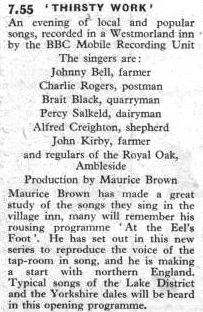
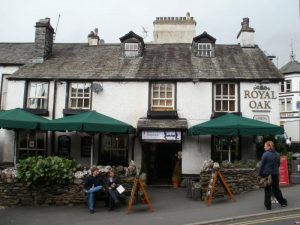
“Maurice Brown has made a great study of the songs they sing in the village inn, many will remember his rousing programme ‘ At the Eel’s Foot’. He has set out in this new series to reproduce the voice of the tap-room in song, and he is making a start with northern England. Typical songs of the Lake District and the Yorkshire dales will be heard in this opening programme.”
In fact all these singers were from Ambleside, and the Yorkshire singers were featured in the second programme, a month later.
Material in the BBC archives has revealed quite a bit of background to this programme. The initial contact was with Ernest Skelton (1876-1954), organist at the Parish Church and music teacher in the town. He was from a very musical family who had previously run the local newspaper, the Lakes Herald; his brother William continued to write for the Westmorland Gazette including a series of biographical sketches, one of these resulted in a book Reminiscences of Joe Bowman and the Ullswater Hounds published in 1921,. This included a song called The Ullswater Pack with music written by Ernest Skelton. Ernest Skelton was the man responsible for “collecting together the singers, arranging for rehearsal and other important matters” according to Maurice Brown and Skelton himself said he thought piano accompaniment would be unnecessary. Brown went ahead and organised a trip starting on 13th March 1940, with two days of preparatory visits (including an outing to Keswick) and two recording evenings in the Royal Oak in Ambleside, on 15th and 16th March. As with all these programmes, the singers were paid 10/6d each, the chairmen and faciitators a guinea or more, and drinks for the whole company of singers were paid for by the BBC.
From this first programme, four songs and some speech are preserved in the British Library Sound Archive on acetate discs. They are not identified as being from this programme, and have the wrong recording date of 28th March 1940. Brait (wrongly transcribed as Bert) Black is named, whilst audience members can be heard exclaiming “Well done, Alf” – Alfred Creighton.
Singers and songs
From the British Library Sound Archive catalogue we know that the four of the songs sung on this occasion were:
- John Peel (unidentified singer)
- Ploughing Song, aka All Jolly Fellows (unidentified singer – but we now know this to be John Bell)
- Sally Gray (unidentified singer – but it is definitely Alfred Creighton)
- Joe Bowman (unidentified singer – likely to be Brait Black)
In the BBC Written Archives Centre, the “Programme as Broadcast” documentation has survived and reveals a further five songs that were included in the programme:
- We’ll All Go a-Hunting
- The Old Rustic Bridge
- New Year’s Hunt at Kirkstile
- The Farmer’s Boy
- Now the Horn of the Hunter is Silent
It seems likely that a couple of these songs were included in another radio programme called Everybody’s Scrapbook in late 1940, and in a letter to the producer of that programme, Leslie Bailey, Maurice Brown wrote about “Joe Bowman’s song” and seems to imply the recording is of Joe Bowman himself singing. However, Brown’s first known recording visit to the Lakes was on 13th March 1940, and Bowman, a legendary huntsman with the Ullswater Hunt for over 40 years had died only a few days before, on 5th March, just fifteen miles north of Ambleside.
I have not yet found any information about Brown making an earlier visit, although it is possible.
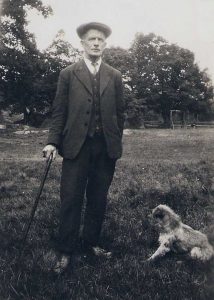 Brait Black – full name Braithwaite Black – would appear to have been at the centre of this occasion, as he was also recorded talking about legendary Lakeland hunter Joe Bowman, and he was clearly a larger-than-life character himself.
Brait Black – full name Braithwaite Black – would appear to have been at the centre of this occasion, as he was also recorded talking about legendary Lakeland hunter Joe Bowman, and he was clearly a larger-than-life character himself.
Black (1883-1944) was the oldest of the singers, in his mid-fifties, and was a quarry worker living with his brother on the northern outskirts of the town. On his death, the Westmorland Gazette published a long obituary (22nd July 1944), describing him as a respected mountain guide, terrier-breeder, hound trailer, athlete and rugby player and member of a male voice choir. I’ve also unearthed a story about him being involved in a mountain rescue in 1934, and a poem – The Ballad of Braithwaite Black – written about that event.
Charlie Rogers (1890-1971) was a postman living on Compston Road in 1939. He was originally from Uckfield in Sussex and moved to Ambleside sometime after 1920.
Johnny Bell (1899-1955) was a farmer born and brought up in Ambleside, also living on Compston Road in 1939 when he was also working for the Lakes Urban District Council, doing haulage work. From information in the BBC archives, we now know that he was the chairman for this singing session.
Percy Salkeld (1896-1955) was another local man who ran a dairy farm and served in the Royal Navy in World War One. In 1939 he was living on Rydal Rd, Ambleside.
John Kirby was described in the Radio Times as a farmer, and information in the BBC archives identifies his home in 1940 as Skelwith Farm, but I have not been able to find out anything further about him.
Alfred Creighton is the other singer who can be identified in the recordings, as the audience can be heard congratulating him by name (“Alf”). Although described as a shepherd in the Radio Times listing, Creighton (1900-1989) always appears in official documents as a gardener, which had been a family trade for decades. He was brought up at Sunnyside Cottages, just outside Ambleside, in an extended family setting, but by 1939 Alf and his wife Florence had moved into the centre of Ambleside on Compston Road where Florence was running a boarding house.
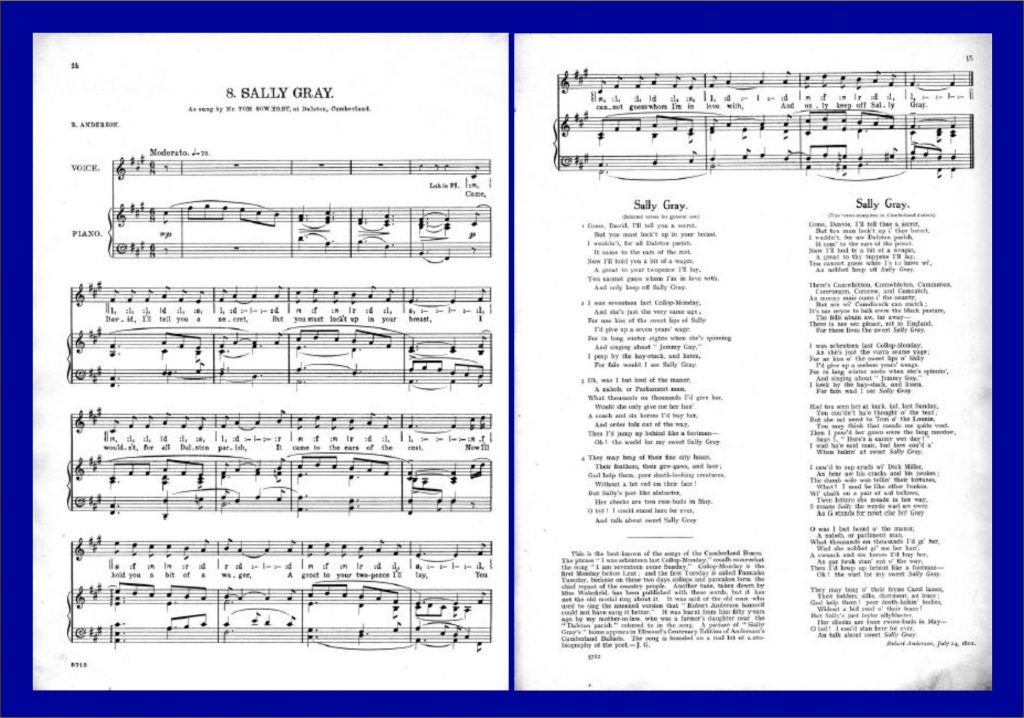
It was Alf Creighton who sang Sally Gray, a song written by “The Cumberland Bard” Robert Anderson in 1802. The image above is taken from John Graham’s 1910 book Dialect Songs of the North.
The majority of these songs are clearly identified with this particular region, whilst others such as All Jolly Fellows, have more widespread appeal, conjuring up a bucolic agricultural vignette which could be from any part of rural England. On he recordings, an unidentified man introduces this song by saying: “There’s been ploughing today, let’s have a ploughing song …” and it turns out that both the chairman and the singer of this song were one and the same person, Johnny Bell. In the following programme, it is the landlord who acts as “chairman” or MC, but in the Royal Oak, the licensee was Mrs Nora Abbott, a widow, who would not have taken this role at that period. Readers will note the complete lack of women in all these listings of performers. Yes, these recordings all took place in the taprooms of pubs, which were largely the dominion of men at the time, but this is not a completely accurate reflection – see Part 3: East Anglia for more comments on this.
Programme 2: The King’s Arms, Redmire, Yorkshire
Broadcast on 4th May 1940
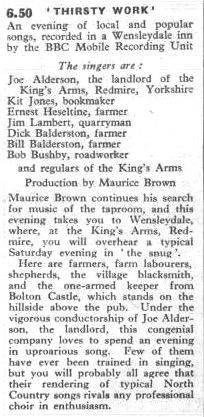
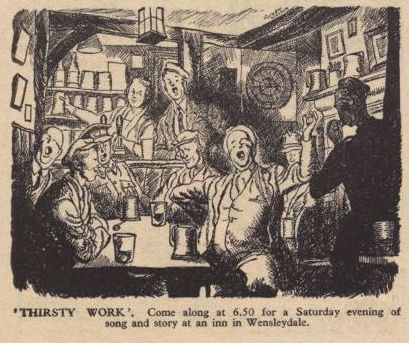
“Here are farmers, farm labourers, shepherds, the village blacksmith, and the one-armed keeper from Bolton Castle, which stands on the hillside above the pub. Under the vigorous conductorship of Joe Alderson, the landlord, this congenial company loves to spend an evening in uproarious song. Few of them have ever been trained in singing, but you will probably all agree that their rendering of typical North Country songs rivals any professional choir in enthusiasm.”
Redmire stands in the shadow of Bolton Castle and many in the village used to be employed on the castle estate. The pub was one of two in the village, and was well-known to leisure fishermen, who could buy their licences to fish on the River Ure on the Bolton Castle estate from the pub’s landlord. The other pub in the village – the Bolton Arms – was later used as a filming location for All Things Great and Small about a Yorkshire vet.
A couple of articles in the Yorkshire Post have provided much useful information about the songs.
“A REDMIRE BROADCAST – Dialect songs from the bar the Kings Arms Inn, Redmire, will be broadcast on the Forces programme on May 4. About 14 Dalesmen will sing old-time songs, unaccompanied. The songs will probably include “Wensleydale” and “White Cockade.” Mr. Kit Jones, aged 77, will sing “The Old Cock crows” and “Selena” with his own concertina accompaniment.”
The mention of “dialect” songs here is interesting: in 1938 and 1939, Redmire had hosted a Dialect Drama festival which was deemed successful and they had looked forward to greater events in the future. The Yorkshire Post (15.4.1940) in its report about the Thirsty Work singing session, claimed that “The fame of these Wensleydale Saturday nights reached the B.B.C. after one of their officials had found a pile of hymns one day on top of a pub piano.” Perhaps that “official” had just come out of one of the Dialect Festival events held in the Town Hall, which adjoins the King’s Arms. It was a BBC official, “Mr Reid” who had put Maurice Brown in contact with the landlord, according to information in the BBC archives, and Brown wrote that “I gather that Mr Reid may be coming professionally” to the recording weekend, which took place on Friday 12th and Saturday 13th April 1940, after a preliminary visit – referred to by Brown as a ‘see and hear’ visit on 30th and 31st March.
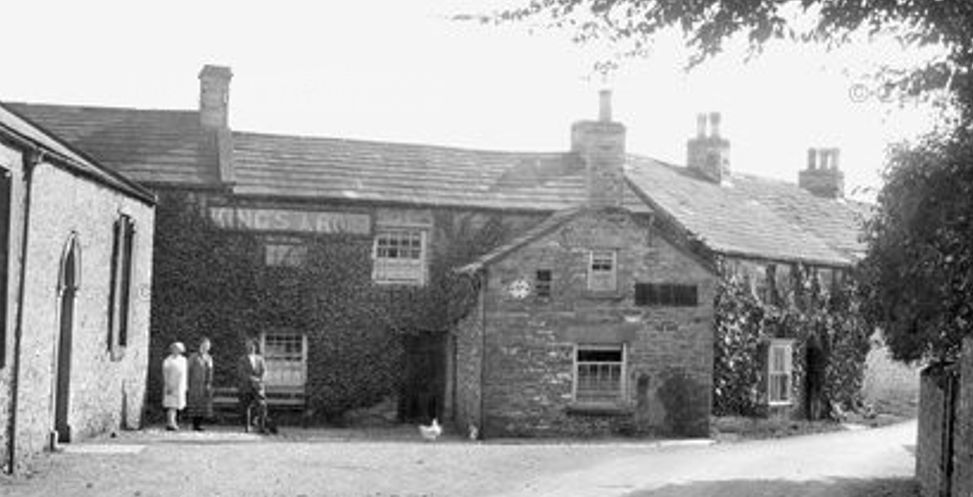 Information in the BBC archives shows that Brown hired a car (for which he had to request petrol coupons from the BBC) to reach this “remote spot” and that sound recordists Neil Hutchinson and AN Other, Mr Reid, and Brown’s secretary, Miss Plummer all stayed at the King’s Arms itself. The correspondence between Brown and the landlord, Joe Alderson, is very warm and friendly and the pub-goers evidently enjoyed a good time during the recordings.
Information in the BBC archives shows that Brown hired a car (for which he had to request petrol coupons from the BBC) to reach this “remote spot” and that sound recordists Neil Hutchinson and AN Other, Mr Reid, and Brown’s secretary, Miss Plummer all stayed at the King’s Arms itself. The correspondence between Brown and the landlord, Joe Alderson, is very warm and friendly and the pub-goers evidently enjoyed a good time during the recordings.
Songs
Two BBC acetate recordings are held in the BLSA, and again just four songs are listed, with two of the performers mentioned in the Radio Times identified: Kit Jones and Jim Lambert.
- I Like to Hear the Old Cock Crow (Kit Jones)
- Our Old Nan’s a Mazer (Jim Lambert)
- The White Cockade (possibly Joe Alderson)
- On Ilkley Moor Baht’at (unidentified singer, but largely choral singing)
BBC archive documentation about the programme reveals that these were selected for “processing” by Maurice Brown on 4th June 1940, out of eight songs which were actually broadcast. In addition the above, these were:
- Wensleydale (sung by “Bill and chorus”)
- What are You going to do about Selina (Kit Jones)
- Maggie (Ernest Heseltine)
- I Shall Know Him
The latter song was one of the Sankey and Moodey hymns for which the pub singers were known. Following his initial visit to the pub on 2nd April, Brown wrote to Joe Alderson requesting some songs heard that night for the actual recording, and mentioning two further songs which do not seem to have been broadcast:
- Rose of Allendale (trio and chorus)
- Rocking the Baby (Mr Heseltine)
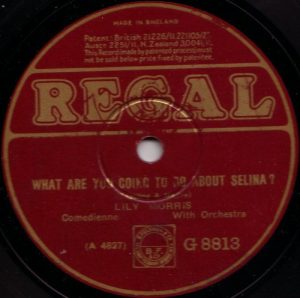 This list of songs comprises folk songs, songs associated with the locality and more modern ones, such as What are You Going to do About Selina, a song made famous in the 1920s and 30s by Music Hall star Lily Morris. A report in the Yorkshire Post mentioned many of these songs and also commented that the men carried on singing after the BBC had finished recording for the night. See References & Links below for the full text of the article.
This list of songs comprises folk songs, songs associated with the locality and more modern ones, such as What are You Going to do About Selina, a song made famous in the 1920s and 30s by Music Hall star Lily Morris. A report in the Yorkshire Post mentioned many of these songs and also commented that the men carried on singing after the BBC had finished recording for the night. See References & Links below for the full text of the article.
Singers
Amazingly, a photograph has recently come to light of the actual radio recording taking place, courtesy of Dales historians Bob Ellis and Ian Spensley. The central figure with the concertina is Kit Jones, and the man whose faces just show above the concertina has been identified as landlord Joe Alderson, thanks to Ian Spensley’s enquiries on my behalf and 96 year old Albert Calvert, who remembers the recording taking place.
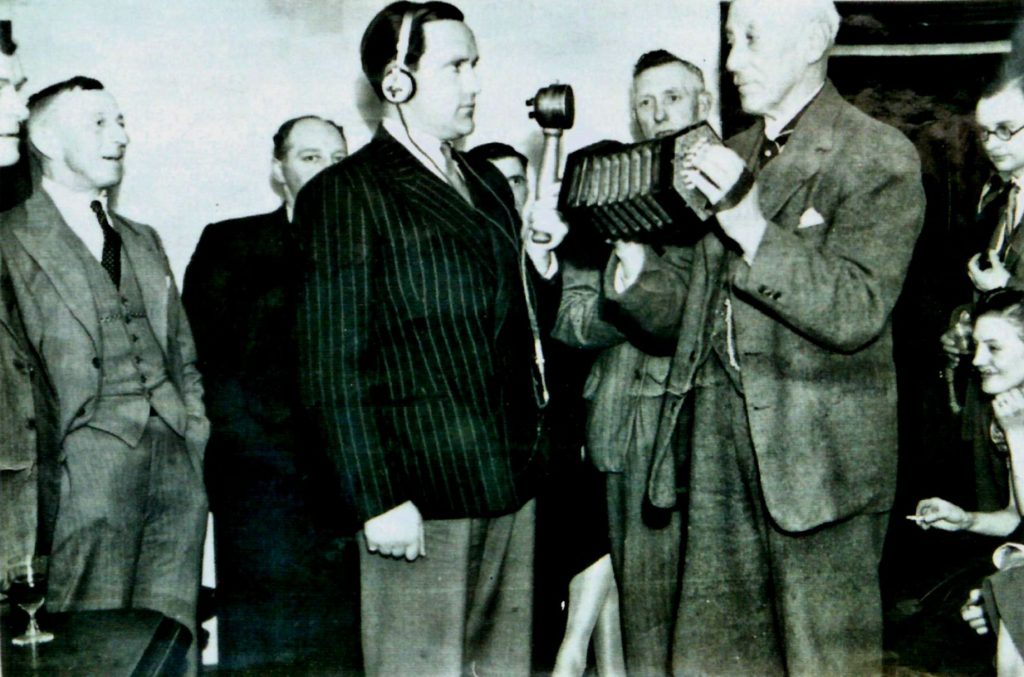
Kit (Christopher) Jones (1869-1957) was described in the Radio Times as a “bookmaker” – this was most probably a sideline (and an illegal one at that) as his main occupation had been as a licensee and hotel proprietor. His wife Ann had been brought up in the pub trade and together they took on the Crown Hotel in the centre of Hawes (they were there at least 1911-1917) and may also have kept the Wensleydale Heifer Inn in another local village, West Witton at some point. By 1939 Kit had retired from the pub trade (although his daughter Mabel continued as landlady of the Bolton Arms in nearby Leyburn) and was living at “The Bungalow” in nearby Preston-under-Scar. Village resident Albert Calvert recalls this as a one-roomed cabin with no facilities and Kit had to use the earth closet in his sister’s garden next door – so not a comfortable retirement! Albert also recalled him playing the concertina out on the hills and entertaining the children with a ventriloquism act. Kit Jones was easily the oldest participant in this Thirsty Work programme, aged 71 at the time.
Jones also had some knowledge of a mumming play and wrote a song called This is the Christmas Time which folksong collector Peter Kennedy recorded from Tom Horner in nearby Swithinwaite in 1959. Kennedy had visited Jones in 1954 (by which time he had moved to Darlington) but found him “not suitable” to record.
Jim Lambert (1890-1971) who sang Our Old Nan’s a Mazer, worked in Redmire Quarry and lived with his wife and family near the Post Office in the centre of the village. The song is a dialect piece, associated with North East Yorkshire and Tyneside.
Joe Alderson (1889-1961) had been licensee of the King’s Arms since around 1930 and remained there for the rest of his life. The pub then changed hands and eventually closed in 2004. In 1960, folksong collectors Nigel and Mary Hudleston recorded Alderson singing The Summer’s Morning, which is a local name for The White Cockade. They noted that it was sung as part of a custom known as the Burning of the Bartle, held every August in nearby West Witton. So it was quite possibly Alderson who sang it for the radio recording in 1940 too.
Bill (1910-1995) and Dick Balderston (1912-1989) were brothers, the youngest men in the gathering, both single men in their twenties, living with their mother on a farm in nearby Aysgarth. Also from Aysgarth was Bob Bushby (1892-1969), a roadman. These three men were known to sing together regularly.
The other farmer amongst the singers, Ernest Heseltine (1896-1982) kept a dairy herd at Hogwra Farm, Redmire, where he lived with his wife and family. Ernest is remembered as a regular in the King’s Arms in the 1970s when Ian Spensley’s family kept the pub.
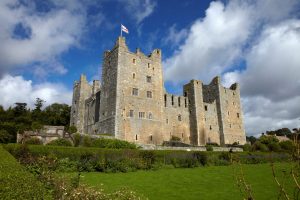
The Radio Times also mentions “the one-armed keeper of Bolton Castle”. This would be John Batty (1886-1960) who is listed in 1939 as the caretaker there – a single man in his early fifties, living with his two unmarried sisters, whose father and brothers also worked on the same estate. The Yorkshire Post article refers to a couple of other people who took part in the chorus singing: “the cobbler” – this would be Tom Hunter, listed in 1939 as bootmaker and auxiliary postman; and “the blacksmith” who was James Robinson, aged 58. Local opinion is that it is James (“Tag”) Robinson on the left behind the presenter in the photograph of the BBC recording.
A list of permissions for broadcast found in the BBC archives has confirmed James Robinson (1881-1972) and Tom Hunter (1879-1971) as taking part, as well as four other men:
Jim Ru(e)croft (1889-1975) was a driver, born and brought up in Redmire, but living in Leyburn by 1939.
James Waller (1876-n.d.) was living on Station Road, Redmire. He seems to have had various jobs and was probably related to the licensees of a pub just outside Redmire, the Swan Inn.
Godfrey Rutter (1876-1972), was originally from Gunnerside, and by 1939 was working in the local quarry and living in the nearby village of Castle Bolton.
Bob Lambert (1895-1978) was a railway clerk living in the nearby town of Leyburn.
A series of letters reveals another man who was also involved, but got missed off the list and subsequently did not receive any payment – which he complained about to the BBC. This was Ralph Bell Fawcett (1892-1969), whose headed notepaper indicates he was a journalist at the Wensleydale Newsagency, Middleham. He claimed he was invited to sing and had been treated unfairly; BBC producer Maurice Brown wrote to the landlord of the King’s Arms, Joe Alderson, with whom he was clearly on friendly terms:
“I am a little worried by two letters from Fawcett, who writes that not only does he think that he has been treated shabbily, but others agree with him in thinking that they were not treated fairly. Could you tell me about this as I should hate to think so happy an occasion should end in discontent. Neither I nor the B.B.C. have any desire to be mean.”
Several references have indicated that the participants here sang as a group, and the same Yorkshire Post article clarifies that they were arranged into tenors and basses. Maurice Brown commented; “I think it is the best natural singing I have ever heard, except the Welsh. It is in no way typical pub singing. They take great trouble with what they call blending.”
One of the singers, a farmer said: “Jazz is no ewse tiv us [ …] we’re partial tiv a bit o’Sankey” – referring to the hymns popularised by American evangelist singer Ira Sankey, known as “The Sweet Singer of Methodism”. They were popular with a number of “traditional” singers including Norfolk’s Sam Larner and Harry Cox.
Traditional Culture in Redmire
The area was also known to American collector J. M. Carpenter who collected a pace-egging (“Pay Segging” on the manuscript) song from Jane Elizabeth Ryder and descriptions of other calendar customs from a Mrs George Robinson in nearby Preston-under-Scar, about a decade earlier. See References & Links section for further details.
Living in a tiny cottage in the village of Castle Bolton, just a few yards from the entrance to the actual castle, was the artist Fred Lawson. Lawson painted many local scenes and wrote in The Dalesman about local events, including traditional events such as Redmire Feast with its “Cheesecake Gatherers”.
You can now read my new article about the Cheesecake Gatherers and Clockdressers on this website.
Programme 7: The Star Inn, Harome, Yorkshire
Broadcast on 7th March 1941
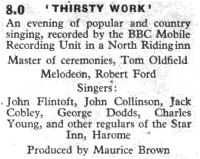
“An evening of popular and country singing, recorded by the BBC Mobile Recording Unit in a North Riding inn. Master of ceremonies, Tom Oldfield; Melodeon, Robert Ford; Singers: John Flintoft, John Collinson, Jack Cobley, George Dodds, Charles Young, and other regulars of the Star Inn, Harome. Produced by Maurice Brown.”
Initially, this programme presented more questions and mysteries than answers, but my visit to the BBC Written Archives Centre revealed a real treasure trove of information about the songs sung, the people who sang them and much more. This section has been totally revised since I first posted about it in November 2021.
I have found no sign of any discs in the British Library from this programme, but a memo from producer Maurice Brown in March 1941 indicates that the original recordings were “processed” – meaning a selection was made for archiving.
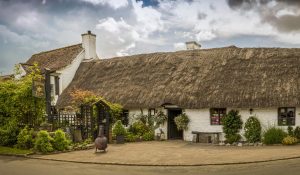
The Star is an attractive medieval thatched building, which until very recently was a famous “gastropub”, but on 26th November 2021 the thatch caught fire and much of the building suffered devastating damage. At the time of the Thirsty Work programmes, the landlord was Tom Oldfield and the pub had been run from at least 1800 by members of his wife’s family. They bought the pub in 1933 and kept it until 1946, being the last members of the family to do so.
It was a man called Sidney Jameson, who suggested the Star Inn to producer Maurice Brown. Jameson (1898-1982), from Butterwick, Barton-le-Street, near Malton, gave his occupation in the 1939 register as news correspondent/journalist. He wrote copious notes to Brown, including biographies of singers. He also made the preliminary visits to the pub (and other possible locations), offered accommodation to the BBC crew and afterwards sent Brown press cuttings from the local newspaper showing some reactions to the programme.
There is no record of Brown making a “see and hear” visit for this broadcast and it seems very probable that he relied on Jameson’s judgement. Jameson had previously explored other pubs in the vicinity in the quest for a suitable location for the radio programme, writing to Brown:
“I also looked in at the Plough Inn at Wombleton, another thatched roof picturesque old place. The people at the inn were very interesting folk. There used to be plenty of singers at the inn formerly, but now they have only an occasional sing song there when the son of the house comes home on leave from the army and brings his accordion. The Helmsley inns too are rather short of local singers. There are a good number of soldiers in the town and district who sing at the inns now. “Mine hostess” and her sister, typical old villagers of the village inn at Nawton near Helmsley said to me on Sunday “They’ve (the military) taken all our men folk away now, but there used to be plenty of singing here formerly.”
Jameson also considered the Buck Inn at Wrelton near Pickering (see below), but when he found the Star Inn, he knew he’d struck gold, and wrote at length to Brown about some of the singers and participants: “George Thomas Oldfield, innkeeper [ … ] is an exceptionally good type. He sings, talks fluently. A jovial personality. [The inn’s] patrons have sung there for generations. There has not been so much singing since the outbreak of war, but there are still plenty of villagers who have sung there and who can give a good musical evening in the old style. “Most of our lads sing at the chapel as well,” says the innkeeper. “And they’re big men at dominoes and darts.”
Jameson’s pivotal role in this programme is shown by Maurice Brown’s memo to his managers on 7th Feb 1941: “Mr Sidney Jameson of Butterwick, Barton-le-Street, near Malton, has gone to immense pains to collect material for me and it is largely through him that this rush programme was successfully recorded. I would be very grateful if he could receive a cheque of not less than 3 guineas, the actual sum I suggest being 5 guineas.”
Brown and his BBC colleague, Mr Chignall, recorded at the Star Inn on 3rd and 4th February 1941. Afterwards, Brown was incapacitated for a while and it was Chignall who compiled the actual programme. Brown wrote to Jameson: “Despite a few points I would have liked changed, I thought the programme went very well, although another five minutes would have made all the difference.”
Singers
Unlike the first two programmes, there was no trace of any recordings in the British Library Sound Archive and the Radio Times gave no occupations, making life even more difficult. There were two Robert Fords and two John Flintofts living in Harome and I couldn’t initially identify any of the other singers in the locality either. However, additional information from the BBC archives and a bit of lateral thinking have eventually resulted in a much better idea of who these singers were.
The Radio Times listed: MC: Tom Oldfield (the landlord) as the MC, Robert Ford on melodeon and singers John Flintoft, John Collinson, Jack Cobley, George Dodds and Charles Young. Additionally, from the BBC archive we now know the following people also took part: Frank Flintoft, Albert Ventress, Archie Greenley, Albert Watson, Reg Marsden and Tom Smith. Apart from the last man, I have now identified all these people.
Tom Oldfield (1884-1975) started out in life as a bricklayer in Norton, near Malton. His first wife died and his second wife came from the Bradley family who had been running the Star Inn since at least 1800. They bought the Star Inn for the sum of £395 in December 1933 and put it up for sale again in 1946.
Robert Ford (1864-1951) was a retired woodsman and general labourer, living on the main street in Harome. From Sidney Jameson’s letters to Maurice Brown, we know that he was highly regarded in the community and led local processions at coronations, jubilees and so on, playing the melodeon. He had bought his first melodeon aged 18 and taught himself to play and had a repertoire of dance tunes, playing a polka for the Thirsty Work programme. Jameson also informs us that Ford had played for the old “granary dances” in the locality, and wrote to Maurice Brown: “Mr Ford is not a “regular” or a frequenter of the inn, but has called in occasionally for a glass of beer. I think he would respond to an invitation to play for you.”
John (1875-1950) and his son Frank Flintoft (1917-2011) were sheep farmers at Church Farm in Harome, although John lived much of his life in Ampleforth, about ten miles to the west.
John Collinson (1883-n.d.) was born in West Hartlepool but from an early age had lived in the village of Nunnington, near Harome. He worked as a road man for the North Riding council.
Jack Cobley (1873-1952) lived all his life in the village of Kirbymoorside, but his wife’s family lived very close to the Star Inn, and so he would have known Harome well. In 1939 his occupation was given as a general labourer, but in earlier life he had worked as a groom, hence his penchant for “horsey” songs!
George Dodds (1900-1986) worked on an estate in 1939, by which date he was living in Harome, having been born and brought up in Wombleton.
Charles Young (1894-1965) was born in North Shields where he started working as a hairdresser. His marriage in 1919 took place in Hawnby, northwest of Harome, suggesting he had moved to this area. By 1939 he was living in the nearby of Helmsley and working as a driver for the Post Office.
Albert Ventress (1912-1990) was described as a woodman in the BBC archives, but in the 1939 register he appears as a steam engine driver (threshing), so it sounds as if he was reliant on seasonal jobs. He lived in Harome for the rest of his life.
Archie Greenlay (1918-1986) was also described as a woodman in the BBC archives. In 1939 he was living a couple of doors away from Albert Ventress, in the Council Houses in Harome and was working as a general labourer. He too remained in Harome for the rest of his life.
Albert Watson (1898-1971) lived his whole life in Harome and in 1939 he was living on The Square and listed as a “permanent way labourer” meaning that he worked on the railway lines rather than on the trains.
Reg Marsden (1898-1972) also worked as a permanent way labourer on the railways. In 1939 his address was 1, Railway Cottages and his wife was listed as the railway crossing keeper. It seems likely that he came from the Stockton-on-Tees/Middlesborough area, and he and his wife married in Otley, West Yorkshire, so it looks as if he moved around a bit.
Songs
- The Doctor’s Shop (John Collinson)
- The Place Where the Old Horse Died (Jack Cobley)
- The Little Shirt
- Leeds Fair (Tom Oldfield)
- The Rover
- Blaydon Races (Charles Young)
- Hull Fishermen (John Flintoft)
- Polka on melodeon (Robert Ford)
In a BBC memo, Maurice Brown wrote to Peter Bax, who wanted to trail the Thirsty Work programme in Programme Parade:
“Songs are for the most part of music-hall foundation with “anon” country twists and variations. Highlights – “The Doctor’s Shop,” a nonsense song sung by John Collinson, a roadman; “The place where the old horse died,” a moving and pathetic ballad sung by a horsey gentleman named Jack Cobley; a polka played by an old man called Robert Ford on a melodeon, which he told me used to be played at dances at dale granaries. He is, I am told, a melodeon “champ”. The local postman, Charles Young, who although he has been at Harome twenty years and won’t go away, still insists on talking in a Shields accent. He will sing “Blaydon Races”. “Hull Fishermen”, which I suspect is broadsheet, sung by a farmer called Flintoft; and “Leeds Fair”, a Yorkshire patter song sung by the landlord, Tom Oldfield.”
This not only gives us information about who sang what, but also demonstrates Brown’s understanding of the repertoire.
After one of his visits to the Star, Sidney Jameson wrote the following to Brown in January 1941, with this affecting vignette of the company:
“There were a few singers including Mr Collinson at the inn. Mr Collinson sang several grand old songs. He is a “star” in his class. John Flintoft famer (father of Frank) sang songs he’d sung at the inn nearly 50 years ago, in Mrs Oldfield’s grandmother’s day. Reg Marsden sang Some people think it’s jolly to lead a single life. Farmer Flintoft and Mr Collinson used to buy penny song books, or sheets, many years ago from “Oad Song Herry” (Old Song Harry) who used to attend the Martinmas hirings and go round the farms buying horse hair, selling laces and songs. Farmer Flintoft said “They’re public house songs ours. We used to buy song sheets off Herry and learn ‘em in t’stables and make up our own tunes to ‘em if we didn’t know t’right ones.”
Sidney Jameson also mentioned that he had heard the following songs sung in the pub:
- Some people think it’s jolly to lead a single life (aka Buy a Little Table) (Reg Marsden)
- My Memory has painted a picture for me (Frank Flintoft)
- It was on a Sunday Morning (Frank Flintoft)
- Roll Along Covered Wagon, Roll Along (Frank Flintoft)
- The Agricultural Show (John Flintoft)
- I’m not the sort of bloke you know that would give a pal away (John Flintoft)
- Once I Loved with Fond Affection (John Flintoft)
- Down the street there’s such a bloomin’ riot (John Flintoft)
- You may ask what makes this darkie weep (Albert Watson)
- Dear Home Across the Sea (Albert Watson)
- The little old log cabin (Albert Watson)
- I Must Go Home Tonight (George Dodds)
- Danny Boy (Tom Smith)
- It was only a beautiful picture (Albert Ventress)
- Two Eyes of Blue (Archie Greenlay)
And, sung by the entire company:
- Come Landlord Fill the Flowing Bowl
- Cockles and Mussels
- My Girl’s a Yorkshire girl
- My bonny
- It’s a long way to Tipperary etc
A Near Miss
Judging from Sidney Jameson’s correspondence with Maurice Brown, another strong contender for a Thirsty Work programme was the Buck Inn at Wrelton near Pickering, where Lilian Knowles was the innkeeper, and about which Jameson wrote:
“I called at the inn on Monday evening and had an interesting chat with the innkeeper and several personalities who live some distance away, from getting down in the evenings. A good company gets together sometimes and has a good sing song, especially about Christmastide. Dan Turnbull, I gathered, gets a bit annoyed when there are three rooms going at the Christmas season and he can’t be choir master in all of including Dan Turnbull, local character. Singing has long been a popular pastime at the Buck Inn though there is not so much done now owing to the black-out which prevents some of the old hands, them. Among the local singers are, Emanuel Ward (village cobbler and violinist), Len Ringrose (farm hand), John Braithwaite, Jimmy Dale and Herbert Dobson (smallholder). Ernest Farmery of Pickering, brother of the innkeeper, visits the inn from time to time. He is a well-known ‘leg puller’ and joker and would certainly be a useful chap in getting together a company of singers at the Buck Inn.”
If anyone would like to follow up this information, do get in touch.
In November 2021 I gave a presentation to the Traditional Song Forum on the Thirsty Work programmes, and was able to include some sound clips from some of the singers in Programmes 1 and 2. This is now on Youtube if you’d like to give it a listen – it lasts about 30 minutes and is the second presentation. The first one is also really interesting, and is about singing in the Lake District, which neatly leads into the first Thirsty Work pub! Here’s the link to my Thirsty Work presentation.
‘Thirsty Work’ Part 1: traditional singing on the radio 1940-41
‘Thirsty Work’ Part 3: East Anglia and the East Midlands – singing from the Eel’s Foot Inn, Suffolk and Wakerley, Northamptonshire
‘Thirsty Work’ Part 4: Cotswolds – two programmes with an unexpected link with “The Archers”: singing from North Littleton and Ebrington
‘Thirsty Work’ part 5: Director’s Cut – recordings from Programmes 5 & 6 and other updates
The Procession of the Clockdressers and Cheesecake Gatherers (Redmire)
I originally found out about the Thirsty Work programmes on the Radio Times Programme Index (previously known as the Genome project), which is very easy to browse and search. Further information on the making of these programmes has been added from the BBC Written Archives Centre, which is by appointment only, in person.
For information and discussions about Ambleside, I am grateful to Sue Allan, and for Redmire, to Bob Ellis, Ian Spensley, Albert Calvert and Steve Gardham. Many thanks to them all for their generous help and interest.
For Ambleside see also:
The website Minor Victorian Writers contains an image of the song Sally Gray as published in Johns Graham’s 1910 book Dialect Songs of the North.
Lakeland Hunting Memories has a lot on Braithwaite Black and a big section on songs.
For Redmire:
The Yorkshire Dales is well supplied by interesting websites including Yorkshire Dales History which has more about Redmire Quarry and Fred Lawson’s painting. For more about Fred Lawson see the Yorkshire Dales website.
The photo of the Redmire recording session was first seen in Bob Ellis’ tremendous book about the instrumental music of the Dales: There was None of this Lazy Dancing! (2020) and comes from the Dales Countryside Museum collection. You can buy his book from the website too.
Also relevant are Dales Genealogy and the Redmire village website.
For references to the audio recordings, see: British Library Sound & Moving Image catalogue
For Peter Kennedy’s recordings in the Redmire area in the 1950s, see the archived website for his recording label, Folktrax. Although the recordings are not currently available, the documentation is still accessible, if sometimes difficult to locate – here’s a direct link to: The Lass of Richmond Hill: Songs and Customs of the Yorkshire Dales
Joe Alderson’s version of The Summer’s Morning has been published in two books: Songs of the Ridings by Nigel Hudleston (1970), and The New Penguin Book of English Folk Songs by Steve Roud & Julia Bishop (2012).
For Yorkshire songs in general, see The Yorkshire Garland website.
If you’d like to read the full report of the recording session, here it is: Yorkshire Post 15 April 1940
Anyone wishing to cite this original research should credit it to Katie Howson and cite this website as the source. © Katie Howson, 2021.
It is due to be published in print form in the near future, and details will be posted here when known. Should you wish to use any of the information or images here, please do contact me first.
I have far more biographical and anecdotal evidence about the singers than can be published here – if you are a relative or a researcher, please do get in touch, I would be very happy to share the information I have.
0 Comments
1 Pingback